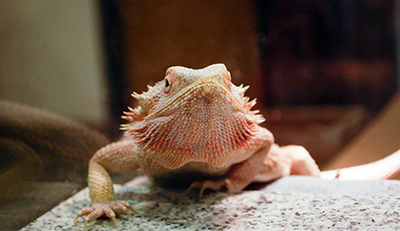
The Animal Rescue League adopts bearded dragons to be family pets. Under no circumstances should bearded dragons be used for food for other animals; for experimentation or laboratory work; or for any other use other than as a family pet. The ARL strictly enforces this policy under the terms of the adoption contract.
About Bearded Dragons
Bearded dragons are lizards that are native to Australia. They live in rocky and arid regions of the country and are adept climbers. In the wild they can be found on branches, basking on rocks, and staying cool in bushes and other shaded areas.
There are eight species of bearded lizards with Pogona vitticeps or the Inland (Central) Bearded Dragon being the species most commonly kept in captivity.
Dragons have large triangular heads and flat bodies with pointed ridges along the sides. Their scales are spiny and appear dangerous but are soft, flexible, and not very sharp. They are omnivorous, eating both insects and plants. These reptiles grow to be 16 to 24 inches long.
Bearded dragons make a great pet reptile. They don’t get too large, eat a wide variety of foods, are active during the day, and are gentle. These friendly animals are captive bred, have limited care requirements, are readily available, and inexpensive. A bearded dragon can be a great addition to your family.
Average captive lifespan is between six and 10 years, though there are reports of specimens living twice that long.
What do I need for my pet bearded dragon?
You want a bearded dragon and want to make sure it receives proper care. To do this you must have everything needed before you bring your new pet home. Below is a list of all the items to keep your new dragon happy and healthy.
Habitat
- A large aquarium or terrarium with a screened top. Get as big a cage as possible.
- A combination light fixture that supports fluorescent and incandescent lights.
- A UVB fluorescent bulb. A good choice is the ZooMed Reptisun 5.0 fluorescent bulb.
- A daylight bulb or heat emitter.
- Substrate for the bottom of the tank.
- A hiding area for your bearded dragon.
- Rocks, branches, or logs for climbing and basking.
- Food bowl, smooth insect bowl, and a water dish.
- Any additional decorations, backgrounds, or artificial plants to make the habitat look more natural.
Insects, Vegetables & Supplements
- Crickets, mealworms or superworms that have been gut loaded.
- Fresh vegetables: mustard greens, collard greens, dandelion greens, or kale.
- Calcium & vitamin D3 supplement powder.
Bearded Dragon Diet
The need of correct diet is quite important. Dragons eat fruits, insects and vegetables which imply that they are omnivorous. The dragons usually like to have earth worms, king worms, wax worms, meal worms and cockroaches etc. They are also fond of crickets and roaches. Dragons should be feed daily. To make the diet more effective one can dust a pinch of calcium on the food which in essential for the growth. Water should be given to them in a fixed quantity as too much water is as dangerous as giving no water at all. This is because they actually come from desert. The dragons generally are not able to make out standing water so misting their enclosure or meal with a spray bottle is a good way to insure hydration.
Habitat
The bearded dragon usually requires a lot of space. A terrarium of 10-15 gallons is of right size for the young hatchlings where as adults may require 50 to 55 gallons size of terrarium. Also there living space should be rectangular as they are semi-arboreal in nature which implies that they require more length than height. A substrate of sand, reptile carpet, newspaper or ceramic tiles should be provided. Sand is not recommended for younger, more clumsy bearded dragons as it may be ingested and cause impaction. Wood chip bedding is also not recommended for dragons of any size.
Lighting
Another important factor in Bearded Dragon care is the amount of light they are exposed to. During the day you need to provide a UVB bulb for your pet along with the natural light as it is essential for the production of vitamin D3 which helps in the metabolism of calcium. In addition to this 14 hours of bright light is required and the rest of the day should be spent in darkness.